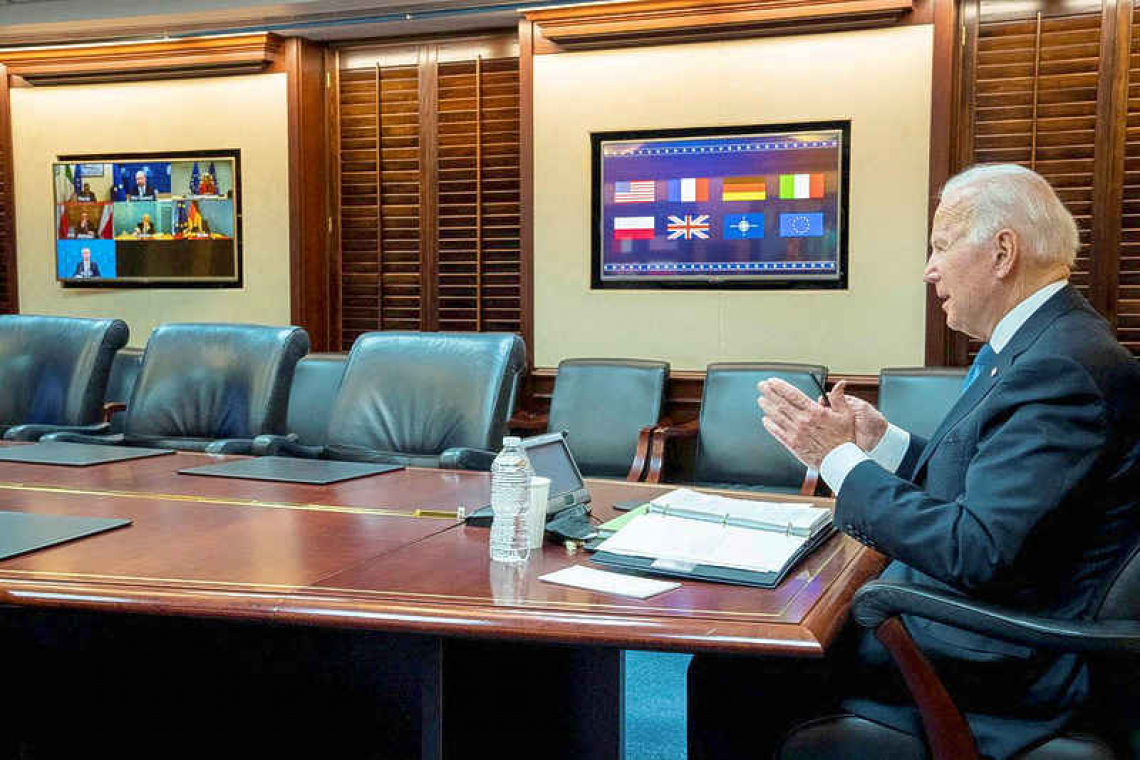U.S. President Joe Biden is seen in a White House handout photo as he speaks with European leaders about Russia and the situation in Ukraine during a secure video teleconference from the Situation Room of the White House in Washington, U.S., on Monday.
MOSCOW/BRUSSELS--NATO said on Monday it was putting forces on standby and reinforcing eastern Europe with more ships and fighter jets, in what Russia denounced as Western "hysteria" in response to its build-up of troops on the Ukraine border.
The U.S. Department of Defense in Washington said about 8,500 American troops were put on heightened alert and were awaiting orders to deploy to the region, should Russia invade Ukraine.
Tensions are high after Russia massed an estimated 100,000 troops in reach of its neighbour's border, surrounding Ukraine with forces from the north, east and south. Russia denies planning an invasion and Moscow is citing the Western response as evidence that Russia is the target, not the instigator, of aggression.
President Joe Biden, pushing for transatlantic unity, held an 80-minute secure video call with a number of European leaders on Monday from the White House Situation Room to discuss the Ukraine crisis. Biden told reporters "I had a very, very, very good meeting" with the Europeans, which included the leaders of Germany, France, Italy, Britain and Poland. He said there was "total unanimity."
A White House statement said the leaders "discussed their joint efforts to deter further Russian aggression against Ukraine, including preparations to impose massive consequences and severe economic costs on Russia for such actions as well as to reinforce security on NATO's eastern flank."
Welcoming a series of deployments announced by alliance members in recent days, Secretary General Jens Stoltenberg earlier said NATO would take all necessary measures. "We will always respond to any deterioration of our security environment, including through strengthening our collective defence," Stoltenberg said in a statement.
He told a news conference that the enhanced presence on NATO's eastern flank could also include the deployment of battlegroups in the southeast of the alliance. So far, NATO has about 4,000 troops in multinational battalions in Estonia, Lithuania, Latvia and Poland, backed by tanks, air defences and intelligence and surveillance units.
U.S. officials said the Pentagon was finalising efforts to identify specific units that it could deploy to NATO's eastern flank. One of the officials said up to 5,000 could be deployed, while a NATO diplomat said Washington was considering gradually transferring some troops stationed in western Europe to eastern Europe in the coming weeks.
Denmark, Spain, France and the Netherlands were all planning or considering sending troops, planes or ships to eastern Europe, NATO said. Ukraine shares borders with four NATO countries: Poland, Slovakia, Hungary and Romania. A Polish official said Warsaw would draw the line at sending troops to Ukraine.
As tensions grow, Britain said it was withdrawing some staff and dependents from its embassy in Ukraine, a day after the United States said it was ordering diplomats' family members to leave. U.S. diplomats are being allowed to leave voluntarily.
Kremlin spokesman Dmitry Peskov accused the West of "hysteria" and putting out information "laced with lies". "As for specific actions, we see statements by the North Atlantic Alliance about reinforcement, pulling forces and resources to the eastern flank. All this leads to the fact that tensions are growing," he said. "This is not happening because of what we, Russia, are doing. This is all happening because of what NATO and the U.S. are doing and due to the information they are spreading."
Global stock markets skidded as the prospect of a Russian attack quashed demand for riskier assets such as bitcoin, and bolstered the dollar and oil. The rouble hit a 14-month low against the dollar, and Russian stocks and bonds tumbled.
Russia has used its troop build-up to draw the West into discussions after presenting demands to redraw Europe's security map. It wants NATO never to admit Ukraine and to pull back troops and weapons from former Communist countries in eastern Europe that joined it after the Cold War. Washington says those demands are non-starters but it is ready to discuss other ideas on arms control, missile deployments and confidence-building measures.
Russia is awaiting a written U.S. response this week after talks last Friday - the fourth round this month - produced no breakthrough.







